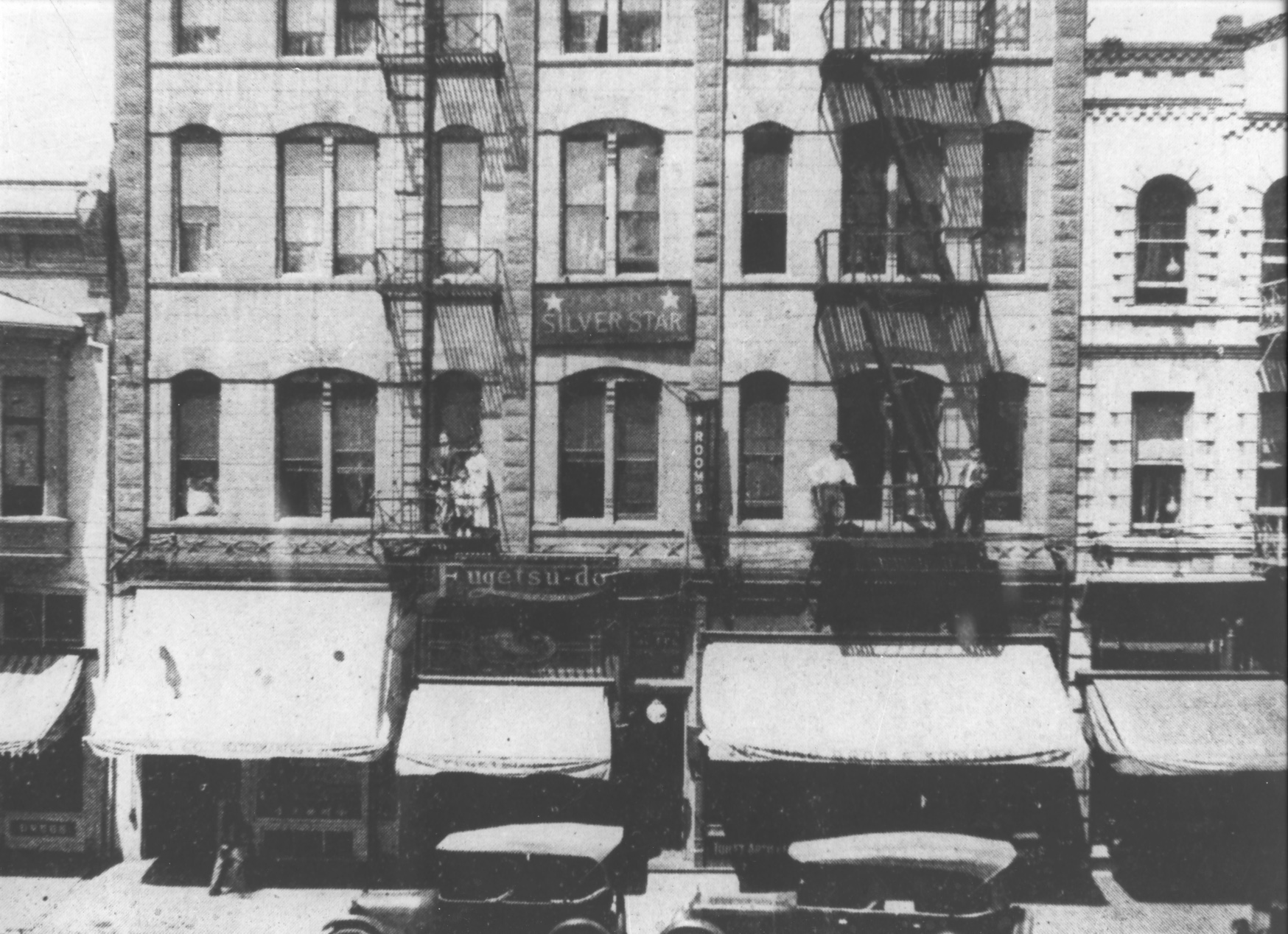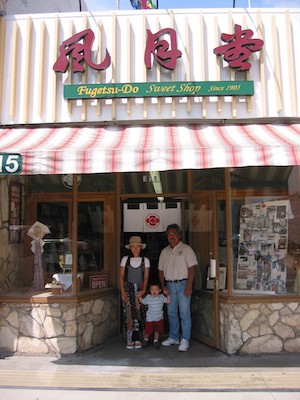

by Nancy Kikuchi

Brian's grandfather, Seiichi Kito, was born in Gifu, in Central Japan. Seiichi came to the United States in May, 1903 and went to where other Japanese immigrants were - in the East First Street district of Los Angeles The Japanese population numbered 3,000 and by November, Seiichi started producing sweets and opened Fugetsu-Do with a couple of friends. As his business partners passed away, Seiichi found himself managing Fugetsu-Do for the next 25 years. Even on rainy and windy days, Seiichi would deliver his sweets. He carried manju and mochi around in a pouch, much like a backpack. READ MORE

Roy became what is known as a kibei - one who is born in the US, but raised and educated in Japan. When he returned to the States in 1935, Roy only spoke Japanese. But, he attended Belmont High School with his brothers and sisters just to learn to speak English. He became involved in all aspects of the family business, as well. As fate would have it, on December 7, 1941, the Japanese bombed Pearl Harbor and President Franklin Roosevelt signed Executive Order 9066, forcing the evacuation of all people of Japanese ancestry. The Kito family was sent to an internment camp in Heart Mountain, Wyoming. READ MORE

Roy
and Kazuko's youngest child, Brian, showed his own entrepreneurial
skills as a teenager when he leased the soda fountain section at the
family store and began his own snow cone business, a big hit during the
annual Nisei Week festivities. Eventually, in 1980, Brian decided to
continue the family business, and has dedicated himself to the task
ever since. Although the number of visitors to Little Tokyo has
decreased in the past several years due to the economic situation in
Japan, Brian counts the local Buddhist Temples and the Japanese grocery
stores as regular customers.
READ MORE

Seiichi and Tei Kito and Children

Exterior of the Store in 1904
Seiichi Kito would distribute early copies of the Japanese American newspaper, the Rafu Shimpo, which was free in those days. Often, people who wanted to pick up a copy of the Rafu, which also began in 1903, would buy something from Fugetsu-Do, as well. So, the two family businesses were helping each other from the earliest days. As time went on, products from Fugetsu-Do were in demand up and down the coast of Southern California.
As Fugetsu-Do flourished, so did Little Tokyo. Fugetsu-Do's success was largely due to the hard work of the entire Kito family. Early account tells of Seiichi's wife, Tei, running the front counter while their six children helped out. Not only the Kitos, but Tei's brother, Sakuma, was very instrumental to the early success of the Fugetsu-Do, as well. This labor-intensive business kept members of both families quite busy.
Little Tokyo was the social, cultural, religious and economic center of the largest concentration of Japanese Americans in the US, and during the holidays, comfort foods were in high demand. Manju and mochi are traditional gifts in the Japanese custom, and during the few weeks before New Year's Day, the entire Kito family would work around the clock to fill the large number of orders.
Seiichi and Tei were to have six more children. But of the twelve children, five did not survive childhood, including the two eldest. Children not making it to adulthood was quite common in those days. And tragically, Tei passed away in 1920, a year after the birth of their son, Roy. Suddenly, Seiichi found himself to be a widower and a single parent of seven children. He was forced to make the difficult decision of having some of his children raised in Japan by in-laws and close family friends. Roy, the youngest child, was one of those to be raised in Japan. Seiichi Kito would later be verified as the inventor of the fortune cookie in a letter dated July 16, 2003 from a member of the Chinese Historical Society of New England located in Boston, Massachusetts.


Kito Family with Roy

Roy Kito standing outside the Fugetsu-Do store
When word spread around camp that Roy was a pastry chef, fellow detainees provided him with their sugar rations, so he could make mochi and manju for them. It was at Heart Mountain that Roy met and married Kazuko. After the war, as the Japanese Americans were being released, the War Relocation Authority encouraged them to move to other locations in the US to minimize hostility, but there was never any question in Seiichi or Roy's mind where they'd go - they would return to Little Tokyo. And they did.
Upon their return, Roy and Kazuko struggled to reestablish the family business. First, they had to retrieve their equipment, but the property owner demanded four years of back rent for storing it. When the Kitos couldn't pay, he kept their machinery. So, they slept at Koyasan Temple while Roy worked as a waiter making 20 cents an hour, but on Boy's Day, May 5, 1946, he re-opened Fugetsu-Do on East First Street, with the help of the Tanahashi Family.
When the building that Fugetsu-Do first occupied was slated for demolition, the shop moved temporarily (two years) to Second Street. During the period between 1956-57, when the current shop was being rebuilt on East First Street, Uncle "Nob" did all the shelving work, and Bob Ing, a popular electrician in Little Tokyo at the time, did all the electrical work. The Kito family holds Bob Ing very dear in their hearts. The reason is that Roy couldn't afford to pay Bob up front for the electrical work. So, Bob agreed to do it all on credit. Roy slowly paid Bob back over the years, but there is no doubt that without Bob's generosity and his trust of Roy, Fugetsu-Do would not have been able to move back to First Street as soon as they did. And, one more note: when the current shop re-opened on First Street in 1957, it was not as a partnership anymore. Roy Kito was the sole owner.


Brian Kito's family in front of the store

Brian Kito and young son Korey making mochi
Roy and Kazuko's youngest child, Brian, showed his own entrepreneurial skills as a teenager when he leased the soda fountain section at the family store and began his own snow cone business, a big hit during the annual Nisei Week festivities. Eventually, in 1980, Brian decided to continue the family business, and has dedicated himself to the task ever since. Although the number of visitors to Little Tokyo has decreased in the past several years due to the economic situation in Japan, Brian counts the local Buddhist Temples and the Japanese grocery stores as regular customers. Japanese holidays such as New Year's Day (1/1), Girl's Day (3/3) and Boy's Day (5/5) also bring an influx of extra business, as special mochi and manju are made for those specific occasions. Many times over the past several years, Brian has contemplated remodeling his shop. However, he hesitates. Yes, he admits, the shop looks old and dated, but that is what his customers remember. He recalled a story of a woman who had lived in Los Angeles over 30 years ago. She was back visiting Little Tokyo and almost burst into tears when she entered Fugetsu-Do. "Everything I remember about Little Tokyo is gone - except Fugetsu-Do. Nothing has changed; the store is just as I remembered it ..." Brian also shared the story of a request he received last year from a bride-to-be in San Francisco. She wanted her wedding photos taken at Fugetsu-Do. Brian obliged, not completely understanding the young woman's motives. It was from the bride's mother that Brian got the full story. This young woman had been very close to her grandmother, who had recently passed away. Most of her memories of her grandmother were of going to Fugetsu-Do together. For this young woman, Fugetsu-Do represented a spiritual connection to her grandmother.
And, as if it was meant to be - and just in time for the celebration - Brian received a letter dated July 16, 2003 from a member of the Chinese Historical Society of New England located in Boston, Massachusetts. All along, the Kito family has made the claim that it was Seiichi Kito, and not a Chinese, who created the fortune cookie. In his letter to Brian, the person talked of finding a 1927 article from a California magazine, which confirmed that the fortune cookie was invented by a Japanese American living in Los Angeles, and that the cookie was copied and popularized by a Chinese American proprietor named David Jung (the first mass producer of the fortune cookie).
There are many more stories to be shared. Brian can talk for hours about the "all nighters" spent making mochi during the week between Christmas and New Year's Day. Not only the Kito family, but all the relatives and cousins, were involved in filling orders. Even today, cousins send their children to Brian to help during the New Year rush. It's almost like a rite of passage for members of this clan - to work at Fugetsu-Do during the New Year season. It's as if the older generation wants the younger generation to experience what they did, so they can share stories and have a common thread that can tie all these families members - young and old - together. Although the art of mochi and manju making has a long history in Japan, Brian keeps his eyes focused on the future, as well. In celebration of Fugetsu-Do reaching its Centennial and being the oldest Japanese-American owned business in the USA, a new product was created - a strawberry flavored-mochi with peanut butter filling.


Korey Kito making mochi*
My name is Korey Kito, I am going to be the fourth-generation master at Fugetsu-do in Little Tokyo. Fugetsu-do is a wagashiya, or Japanese confectioner. When I was born, my parents actually lived in Little Tokyo, so I have been coming into Fugetsu-do since infancy. My fondest childhood memories are when I started learning about mochi alongside my father when I was about three or four years old. I continue to build my skills in Japanese confectionery as an apprentice to my father and have mastered the Kurimanju (chestnut manju) which is difficult to learn. I enjoy making mochi and I want to do this my entire life and to continue the Fugetsu-Do history into the future. When I take over, I hope I will be successful. I do not want to stray away from my culture because that is really built up. I just hope I can leave my mark in a great way. Culture is really important to me. Little Tokyo seems like it is turning less and less Japanese over the years and everything around us has been changing, so I really want to keep Fugetsu-Do there and keep it open for another 100 years.
*Interview and image source: CRFT by Maki video | Kito Family portrait by Toyo Miyatake Studios
 The Washington Post |
KCRW |
KCET |
LAWEEKLY |
ABC7 EYEWITNESS NEWS |
BUZZFEED |
PBS SOCAL |
FOOD INSIDER |
Candy Atlas
The Washington Post |
KCRW |
KCET |
LAWEEKLY |
ABC7 EYEWITNESS NEWS |
BUZZFEED |
PBS SOCAL |
FOOD INSIDER |
Candy Atlas